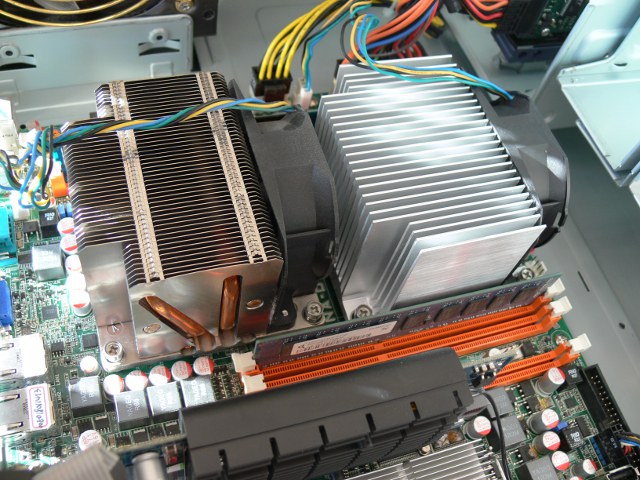



As I had to look for a cooling solution for a dual Socket 1366 system, I was pointed to the Intel STS100 Series products as being the only ones that would fit on my board. Unfortunately, the page on the Intel site doesn't mention any technical details, and I wasn't able to find any review of these products. Now that I got my hands on a STS100C and a STS100A, I will attempt to fill the gap by publishing a full review of them.
| STS100C | STS100A | Comments | |
|---|---|---|---|
| Socket type | Intel LGA1366 | ||
| Maximum CPU TDP | 130 W | 80 W | |
| Cooler dimension | 64 (H) x 90 (W) x 90 (D) mm | Screws excluded | |
| Heatsink material | Copper base and heatpipes, aluminum |
Aluminum | |
| Fin count | 48 | 25 | |
| Heatpipe count | 4 | 0 | |
| Weight | 540 g | 485 g | Fan included (80 g) |
| Installation | Screws and retention backplate | Backplate not included in the box | |
| Fan dimension | 61 (H) x 88 (W) x 25 (D) mm | Removable but non-standard | |
| Fan speed | 823 - 8035 RPM | ? | Measured |
| Current rating | 0.47 A | ||
| Voltage rating | 12 V DC | ||
| Fan connector | 4 pins | ||
| Boxed product code | BXSTS100C | BXSTS100A | |
| Typical retail price | 33 € | 23 € | France, 2011 |
Installation is fairly easy. The heatsink has 4 screws which fit perfectly in the backplate. Just make sure you follow Intel's recommendations.
Note that the fan pushes the airflow through the heatsink, so if you want the air to flow from front to back in the case, the fan must be on the front side.

STS100C (left) and STS100A (right) thermal solutions installed on an
Asus Z8NA-D6 mainboard
The following tests were achieved with a case temperature of about 36°C. The STS100A wasn't installed yet, so only the STS100C was tested. I'll update this section when I find the time to test the STS100A.
Using the "Whisper Mode" for fan speed control in the BIOS, the fan spins at about 850 RPM when the machine is idle. It's pretty quiet. In fact, I can hardly hear it, especially when compared to my other machines. With the CPU fully loaded, the fan reaches the speed of about 1700 RPM. Now I can hear it, but it's still reasonably quiet.
With this setup, the CPU temperature climbs to 15°C below its critical limit. As soon as the load stops, it gets cooler quickly (-14°C after one minute) and the fan is back to its cruise speed (850 RPM). So even in quiet mode, the STS100C is very effective.
In manual control mode, the fan speed can be set from 800 RPM to about 8000 RPM. Needless to say, if it is near silent at the lower end of this range, it is awfully noisy at the higher end. Nobody would want to run the fan at 8000 RPM in a desktop environment. This high speed is clearly meant for racked servers in server rooms.
When forced to full speed, the fan shows its cooling potential. The idle CPU temperature is down by 8°C after just a few seconds, by 14°C after one minute, and by 18°C after two minutes. In this mode, even with the CPU fully loaded, the CPU temperatures stayed 32°C below the critical limit. Even if I don't plan to ever run the fan at this speed, it's good to know what it is able to do in case of overheating emergency.
I tested the response to a PWM fan control signal at different frequencies. The result is good overall. At high frequencies (1 to 130 kHz), there is an almost perfect linear range from 15% to 100% duty cycle. At lower frequencies (16 to 128 Hz), the control range expands to lower duty cycles at the price of a degraded linearity. High frequencies seem preferable, resulting in a very smooth fan control with no acoustic downside. Intel recommends using a frequency between 21 kHz and 28 kHz.
Good stuff. Not too expensive, quiet at low speeds, efficient at high speeds, I could hardly hope for anything better. Great job, Intel!